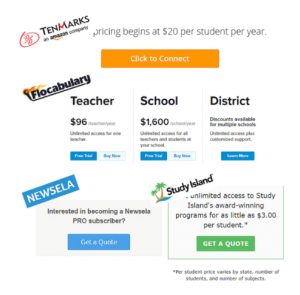Understanding Ed-Tech Product Pricing, for Educators and Entrepreneurs
 You expect that when you search for a book on Amazon, or a sweater on Zulily you’ll find the price front and center. It’s normal in the consumer world. But in business-to-business sales, like in education technology, it’s not always that easy. Some ed-techs companies list their prices, others don’t. That often leaves teachers and administrators scratching their heads.
You expect that when you search for a book on Amazon, or a sweater on Zulily you’ll find the price front and center. It’s normal in the consumer world. But in business-to-business sales, like in education technology, it’s not always that easy. Some ed-techs companies list their prices, others don’t. That often leaves teachers and administrators scratching their heads.
TenMarks gives a starting price point per student and StudyIsland also gives an indication of its lowest student price. Newsela doesn’t list any pricing but asks you to get a quote. BetterLesson doesn’t appear to mention pricing for it’s personalized PD. Flocabulary, a site that uses songs and hip-hop to meet Common Core standards, lists its pricing very clearly and gives users an easy way to purchase online.
Many ed-tech companies use a “freemium” model, which means they offer part of the product for free and make premium or advanced features part of a paid subscription. That’s what we do at Listen Current. But that can make even finding pricing confusing because teachers can use and explore the site without understanding there’s a pay wall, until they hit it.
With the proliferation of subscription ed-tech products, you would think it would be easy to just list a price. Before I started my company it didn’t occur to me why you wouldn’t list prices front and center. But I’ve learned that as a new company still trying to determine the best price and product market fit, at this stage, listing one price could be a disadvantage for our customers. We don’t have a recognizable brand name that will automatically communicate value. For example, if you haven’t tried the Listen Current Premium and all you know is the price, you might be ruling something in or out without evaluating whether it’s worth it. As we learn about our sales process and how people evaluate the product we’ll learn more about pricing.
Schools vary in size so it’s hard to make a pricing structure that makes sense for the small private school serving students with disabilities and the large public high school in Palo Alto, Calif. In addition, we offer a variety of pricing levels that would be complicated to list on our website. It’s better explained in person.
But Alex Rappaport, the co-founder and CEO of Flocabulary says he believes in simple straightforward pricing because “if you can’t explain your pricing to an administrator in 30 seconds or less, it’s probably too complicated.” He prioritizes sales efficiency.
He says many publishers’ pricing models are full of “byzantine pricing tiers” that waste time.
“When we’re making a decision about plans and pricing, the guiding mantra is keep it simple and easy to buy,” says Rappaport.
There are advantages and disadvantages in both approaches. The advantage for administrators in working with companies that don’t list their prices is that you can have a more complex pricing proposal that tailored to your unique situation. The disadvantage is that this evaluation process will take longer.
In the end, I believe different customers have different needs and that’s why we don’t list our prices. We share our price list to potential customers and talk about what is best for a school or district. But having a conversation around price, I believe, is better than flatly stating prices online with no interaction with schools and districts around their needs and budget. This allows for maximum flexibility to meet the needs of customers, which we can do as a start-up that is still learning about the market and pricing.
See also:
- Navigate the Ed-Tech Marketplace to Get Your Product Into Schools
- Going Back to School to Learn About Blended Learning
- The Risks of Ed-Tech Entrepreneurship
For more information visit @ListenCurrent on Twitter.
